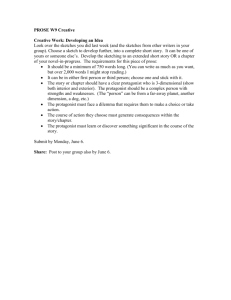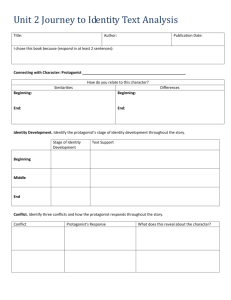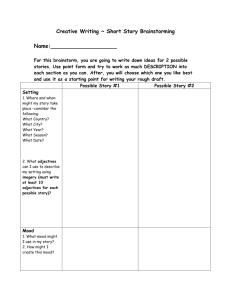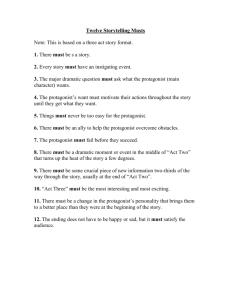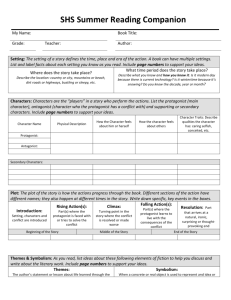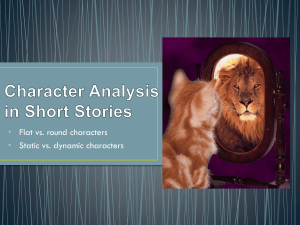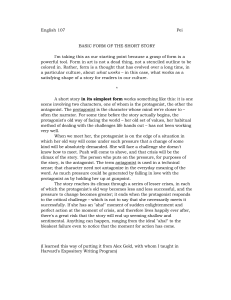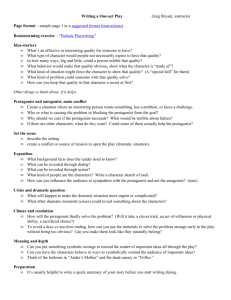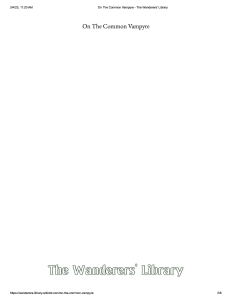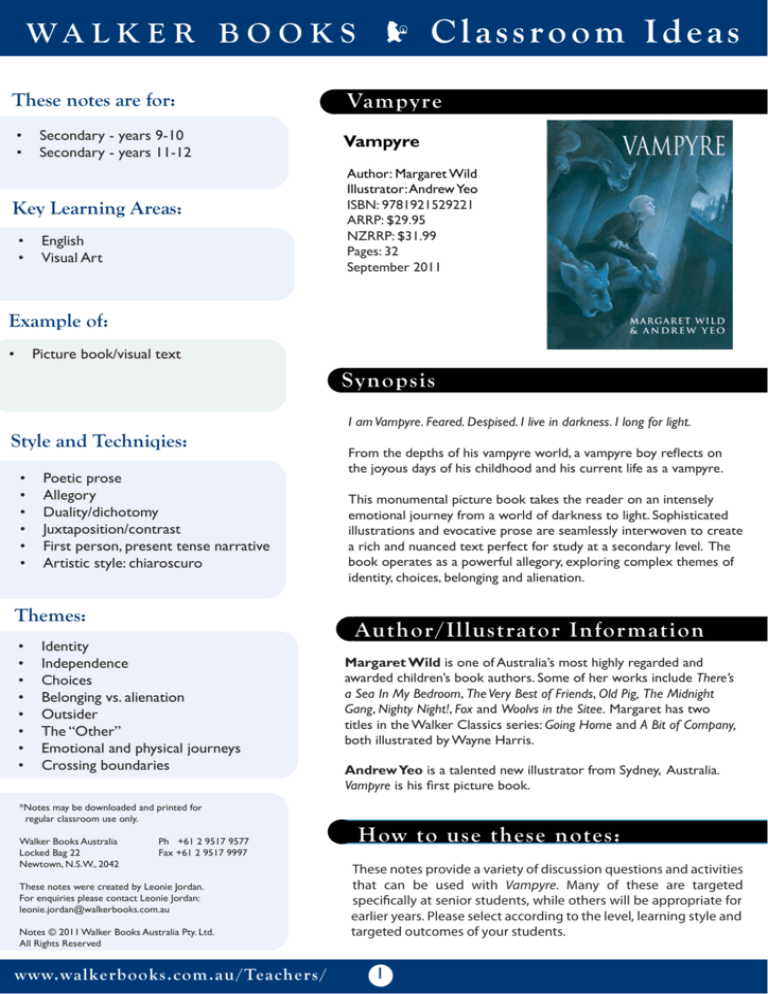
WA L K E R B O O K S
Classroom Ideas
These notes are for:
Vampyre
•
•
Vampyre
Secondary - years 9-10
Secondary - years 11-12
Key Learning Areas:
•
•
English
Visual Art
Author: Margaret Wild
Illustrator: Andrew Yeo
ISBN: 9781921529221
ARRP: $29.95
NZRRP: $31.99
Pages: 32
September 2011
Example of:
•
Picture book/visual text
Synopsis
I am Vampyre. Feared. Despised. I live in darkness. I long for light.
Style and Techniqies:
•
•
•
•
•
•
Poetic prose
Allegory
Duality/dichotomy
Juxtaposition/contrast
First person, present tense narrative
Artistic style: chiaroscuro
Identity
Independence
Choices
Belonging vs. alienation
Outsider
The “Other”
Emotional and physical journeys
Crossing boundaries
*Notes may be downloaded and printed for
regular classroom use only.
Walker Books Australia
Locked Bag 22
Newtown, N.S.W., 2042
This monumental picture book takes the reader on an intensely
emotional journey from a world of darkness to light. Sophisticated
illustrations and evocative prose are seamlessly interwoven to create
a rich and nuanced text perfect for study at a secondary level. The
book operates as a powerful allegory, exploring complex themes of
identity, choices, belonging and alienation.
How t
Themes:
•
•
•
•
•
•
•
•
From the depths of his vampyre world, a vampyre boy reflects on
the joyous days of his childhood and his current life as a vampyre.
Ph +61 2 9517 9577
Fax +61 2 9517 9997
These notes were created by Leonie Jordan.
For enquiries please contact Leonie Jordan:
leonie.jordan@walkerbooks.com.au
Notes © 2011 Walker Books Australia Pty. Ltd.
All Rights Reserved
www.walkerbooks.com.au/Teachers/
Author/Illustrator Information
Margaret Wild is one of Australia’s most highly regarded and
awarded children’s book authors. Some of her works include There’s
a Sea In My Bedroom, The Very Best of Friends, Old Pig, The Midnight
Gang, Nighty Night!, Fox and Woolvs in the Sitee. Margaret has two
titles in the Walker Classics series: Going Home and A Bit of Company,
both illustrated by Wayne Harris.
Andrew Yeo is a talented new illustrator from Sydney, Australia.
Vampyre is his first picture book.
How to use these notes:
These notes provide a variety of discussion questions and activities
that can be used with Vampyre. Many of these are targeted
specifically at senior students, while others will be appropriate for
earlier years. Please select according to the level, learning style and
targeted outcomes of your students.
1
WA L K E R B O O K S
Pages 1-2 (“Bellini walked beside the Bay…”)
Classroom Ideas
Margaret Wild on Vampyre
“I don’t write much fantasy, so I never planned to write a story about a vampire boy. But when I stumbled across the word
“vampyre” this unusual spelling sparked my imagination. It seemed ancient and evocative, and I also liked the fact that “pyre” with its
connotations of burning was part of the word.
At the back of my mind, too, was the pressure that some parents put on their children to join the “family business”. So I wondered
what would happen if a vampire teenager decided he was going to take a different path and how would he achieve it …
When I wrote the story I was aware that there were many “vampire” books around, so I was delighted when Sarah Foster, the
publisher of Walker Books, liked this story and wanted to publish it. She teamed me up with a brilliant new illustrator, Andrew Yeo.
This is his first book and I think it’s an incredible piece of work – very moody and beautiful and I love his use of dark and light.
I haven’t actually met Andrew yet. This may seem surprising but it often happens with the creation of a picture book, for various
reasons. He worked very closely with the art director and editor, and I was shown his work at progressive stages, from pencil
roughs to finished artwork.”
Andrew Yeo on Vampyre
“The illustrations attempt to capture an internal desolation evocative of the text, drawing inspiration primarily from the
introspective atmosphere of Rembrandt, and coupled with the melancholy grandure found in Romanticism's aesthetics and its
sensibilities.”
In the Classroom
Before Reading
•
What do you expect this story to be about? What genre do
you think it will be?
•
When and where do you think the story is set? What gives
you this impression?
•
Without having read the story, what is your impression
of the character depicted on the front cover? How would
you describe his facial expression and body language? What
emotions do you think he is experiencing? Does he seem a
character the viewer is supposed to empathise or identify
with or is he presented as distant and ‘other’?
www.walkerbooks.com.au/Teachers/
•
2
Write a vignette inspired by the cover of the book.Your
vignette may describe events that occurred immediately
before or after the scene, could portray the character’s
internal thoughts and feelings, or could explore a theme or
mood suggested by the illustration.
WA L K E R B O O K S
After First Reading
•
•
After reading the book for the first time, write a journal
entry focusing on your own response. What emotions did
it arouse? Which parts of the book affected you the most?
Did you relate to any of the characters? Were there any
immediate messages you took away from the book? Are
there any questions you have?
the capital letter play? How
would
ow
ww
o ld the effect have altered if
ou
he had said, “I am a Vampyre”.
yree”.
•
What conflict is introduced
two
ed inn tthe
he finnal
a tw
al
wo lines? How is
wo
this binary reflected in thee illu
illustrations
ustr
t at
atio
i ns
ns acc
accompanying
compaany
nyin
ingg the
text?
•
ble o
nvis
isib
ible
blee, which
whhicch draws
draw
dr
aws
ws
A vector is a line, whetherr visib
visible
orr iinvisible,
the eye in a particular direction
ectionn o
orr to a partic
particular
cul
ulaar obj
object.
bjj
bject.
ors inn this
th iimage
mage aand
ma
nd
d iidentify
deennttif
tififyy th
thei
eirr
ei
Locate the following vectors
their
igh
ghliigh
ghtt a ppa
art
rticul
ular o
bjjecct or to
bjec
purpose. This could be to hi
highlight
particular
object
or m
moo
ood
oo
ood:
create a particular feeling or
mood:
ecks
- the gargoyles’ bowed necks
here the boy
oyy iiss llooking)
ook
okin
i g)
- the subject’s gaze (i.e. where
oyle in the foreg
groun
rou d of the
ro
hee
- the right ear of the gargoyle
foreground
picture
- the ears of the gargoyle below the balcony
- the edges of the balconyy
iicctu
turre
- the lines of the building in the foreground of the ppicture
uildings in the background
do
the
the
- the silhouettes of the buildings
off th
picture.
Are there any other vectors you can identify in this image?
•
What attitude towards the protagonist is suggested by the
positioning of the gargoyles? Do they seem to be bowing
down to him? Protecting him? Looming over him in a
threatening manner? Imprisoning him?
Wild writes, “As with most of my stories, it is the emotions
in the text which interest me most.” What adjectives would
you use to describe the mood, or dominant emotion, of
the book? Compare your adjectives with a classmate’s.
Close Reading - Page by Page
Cover
•
Consider the author’s spelling of the word “vampyre”. How
do the connotations of this word differ from the more
conventional “vampire”? What ideas or images do you
associate with it?
•
What are the dominant colours used on the cover? What
mood do they create? Look closely at the illustrator’s use
of colour around the boy’s profile. What might this suggest?
•
•
How has the illustrator established a relationship between
the gargoyles and the boy through the composition of the
cover image? What might he be trying to convey through
doing this? Think particularly about the ideas associated
with gargoyles. For instance, monstrosity, superstition, the
Medieval period and “stoniness” or a lack of feeling.
Comment on the font used on the cover. What words
would you use to describe it? Use the font tab in
Microsoft Word or a similar program on your computer
to experiment with different fonts for the title.You may
also like to vary the use of capitals letters and lower case.
Choose the three representations you consider most
effective and present these to the class, explaining why you
have chosen them.
Pages 3-4 “Fully grown, I am now ...”
•
How does the protagonist feel about his “role”? How
do we know this? Consider facial expression and body
language.
•
Why has the illustrator again chosen to position the boy
amidst the “pack” of gargoyles? Who might the gargoyles
represent in this instance?
•
The brevity of Wild’s language draws attention to
contrasting images and ideas. What is unexpected, and even
shocking, about the juxtaposition of the words “embrace”
and “attack” and “kill”?
Title Page
•
How has the notion of duality (two-sidedness) been raised
in the title page?
•
What are some ideas typically symbolised by birds? (Some
possible answers could be freedom, peace and escape.)
How do these ideas correspond with the ethereal, almost
ghostly appearance of the birds on the title page? What
might these birds represent?
•
Pages 5-6 and 7-8 “I loved being a child ...” and
“playing hide-and-seek ...”
•
The narrator shifts tense, adopting the past tense to
reminisce fondly about his childhood. How does this
change your attitude towards him?
•
What is unexpected about the narrator’s daily routine as a
child? Without these details, would you have viewed him as
anything other than a typical, happy child? Can you relate
to any of his memories?
•
How do the text and images work together to establish a
sense of belonging in this double-page spread? How does
this contrast with the preceding pages?
The composition of the title page suggests the phases of
the moon. Why might Yeo have introduced this idea?
Page 1-2 “I am Vampyre ...”
•
Wild introduces her protagonist in the first person. Why
might she have adopted this voice?
•
The protagonist identifies himself as “Vampyre” rather than
providing a name. Why does he do this? What role does
www.walkerbooks.com.au/Teachers/
Classroom Ideas
3
WA L K E R B O O K S
Pages 9-10 “I loved being a boy ...”
•
Identify the author’s use of repetition. What tone does
this create? Wistful? Regretful? Nostalgic?
•
Copy out the verbs used in the text on each page. What
ideas are suggested by each verb?
•
•
while an “offer” is when no direct eye-contact is made
and the viewer is free to look where they please.) What
effect does this gaze have?
Pages 13-14 “And in the villages ...”
•
The narrator’s use of language alters as he remembers
his childhood, with the sentences becoming longer
and more fluid and rhythmical. Why has this change
occurred? Think particularly about the protagonist’s
emotions.
Why is repetition used at this point of the story?
Consider both what has happened before and what
change takes place on the following pages.
•
The gazes of the animals and boy are all directed at the
one spot. How does this help create a sense of belonging
and acceptance?
What is the significance of the sharpened stakes the
villagers are armed with? What are some other popular
beliefs about vampires? (You may like to use the internet
to research this.)
•
How does Yeo use visual techniques to convey the
villagers’ hostility towards the protagonist? Some ideas
could include:
- the villagers’ faces being covered by their helmets,
suggesting coldness, anonymity and an unwillingness to
engage
- their spears creating vectors pointing at the protagonist
- the diagonal slope of the rooflines in the background
creating an additional vector to the protagonist
- the lit windows of the houses in the village evoking
eyes staring down accusingly
- the composition of the image, with the edges of the
mountains hemming in, or entrapping, the protagonist
from both sides of the page
- the positioning of the protagonist alone in the
foreground, emphasising his alienation and powerlessness
in contrast to the villagers’ communal strength
- the use of a subtle low angle perspective to emphasise
the villagers’ power over the protagonist
- the protagonist’s cowering body language, protective
hand gestures and fearful facial expression further
emphasising his vulnerability
- and the protagonist’s upturned face and gaze acting as a
vector to the aggressive villagers.
•
The herd of deer is an inversion of an earlier image
from the book, imitating it while radically changing the
meaning attached to it. Which earlier image does it bring
to mind? How are these two images both similar and
different?
•
How does the composition of the double-page spread
suggest the protagonist’s sense of freedom as a child?
Think particularly about the relative size of objects and
their positioning. Is this freedom real or just illusory?
Explain your answer.
Pages 11-12 “Birds shun me now …”
•
How has the protagonist’s situation changed now that
he has matured? How is this contrast emphasised by the
structure of the language? (Think particularly about the
number of lines on the page.)
•
Write a list of synonyms for the word “shun”. Read the
sentence aloud, substituting a new word for shun on
each occasion. How does the feeling of the line alter
with each new reading? Write a mood poem inspired by
the word “shun”.
•
Why does Yeo present this scene from an overhead,
or bird’s-eye, perspective? How does this choice of
angle make the protagonist appear? Experiment with
redrawing this scene from other angles such as eye-level
and low-angle. How does this change the mood of the
illustration?
•
What directions are the birds facing? Do they seem
afraid of the boy or merely indifferent? How are they
positioned to focus attention on the boy? Does this
vantage point make you feel distant and detached from
him, as if you were a scientist viewing him through the
lens of a microscope, or does it instead emphasise his
loneliness, vulnerability and isolation? Compare your
response with a classmate’s.
•
Classroom Ideas
Pages 15-16 “I repudiate my ancestry ...”
•
What connotations does the word “repudiate” have?
For instance, it could sound haughty and lofty, suggest a
religious renunciation or casting off, or evoke the legal
system. What do you think the protagonist means when
he says he repudiates his “ancestry”, his “destiny?” How
does his family respond? Why do you think they respond
in this way?
•
How are the colours in this spread different to those
used in earlier ones? Why has this change occurred?
What mood does it create? Is this mood appropriate for
the scene, in your opinion? Explain your answer.
•
In what ways is this illustration reminiscent of a classical
religious painting? Think particularly about the body
language of both the father and mother. (It may be helpful
to look up the definition of “pieta”.) Do you think this
resemblance is deliberate on the part of the illustrator?
Is the protagonist’s gaze an example of an offer or a
demand? (A “demand” is where direct eye contact is
made with the viewer, thus compelling their attention,
www.walkerbooks.com.au/Teachers/
4
WA L K E R B O O K S
Pages 17-18 “Late one afternoon ...”
•
•
•
Yeo has used the gargoyles as a framing device for the
image. What ideas is he trying to emphasise through doing
this? Think particularly about the textual symbolism of
the gargoyles and the attitude they convey towards the
protagonist’s actions.
What is the significance of the protagonist going out
into the sun? Think especially about the verbs Wild uses
to describe his actions. Do you interpret his actions as
teenage rebellion? Disloyalty to his family? Attempted selfannihilation? Self sacrifice? A gesture of independence? An
attempt at redemption? Something else altogether? Discuss
your answer with a classmate. Is their interpretation similar
or different to yours?
•
How has the protagonist’s mantra (repeated statement of
belief or identity) changed? Why has this change occurred?
•
Compose a diary entry for the protagonist as he prepares
to venture outside. Focus particularly on his feelings and
motivations rather than his actions. What fears, regrets and
uncertainties might he be experiencing as he waits? What
has prompted him to make this decision now? What are his
hopes and expectations for the future?
Pages 23-24 “The sun blazes ...”
What contrasting images or ideas are expressed in the
language used on these pages? For example, the son’s
cautious “creep” as opposed to the father’s frantic “dash”.
How does the layout of the text visually enact the idea of
duality or binary oppositions?
•
How is the protagonist’s vulnerability portrayed in this
double-page spread? Think about composition, angle, colour
and size.
•
What is the main feeling or emotion this image evokes in
you? Compare your response with a classmate.
•
How does Wild’s language suggest energy and
determination? Consider sentence and word length, pace
and verb choice.
Pages 19-20 “I am ill ...
•
•
•
Pages 25-26 “Deep in the abyss ...”
The protagonist claims his father, “belts him with words”.
What is suggested by this metaphor?
•
Does the boy’s description of his father match the
accompanying illustration of him? What might this suggest
about his reliability as a narrator?
How does Wild intensify her language to reflect the
protagonist’s frantic efforts to climb out of the abyss? Think
particularly about the role of punctuation.
•
What is the main technique the illustrator uses to emphasise
the arduousness of the protagonist’s struggle?
•
Can the protagonist’s climb out of the abyss be seen as a
symbolic test of strength or endurance? What do you think
is at stake? Can you think of any parallels from literature or
art?
Write a scene showing the conversation the mother and
father might have had as they tended their ailing son. Explore
their differing attitudes towards him, as well as the reasons
for their actions.
Pages 21-22 “I am Vampyre”.
•
•
•
•
Classroom Ideas
Pages 27-28 “ I emerge scorched ...”
How are visual techniques used to reinforce the
protagonist’s decision to separate himself from his family?
Consider light and colour, vectors and the positioning of
characters.
The protagonist’s hand creates a vector towards the door,
while his gaze creates an opposing vector towards his
sleeping family. What does this suggest about his internal
state?
Curtains are a key element of the mise-en-scene on this
page and in the preceding one. What might the curtain
symbolise? Some ideas to consider could include:
- the curtain as a symbolic barrier or division, with the
protagonist having left childhood through his actions
- the notion of enlightenment or understanding suggested by
curtains being pulled aside
- concealing or hiding shame
- acting, pretence and illusion versus reality, as suggested by
associations with the theatre.
How has the mood altered in this spread? How is this
portrayed through colour and light?
•
What literary techniques does Wild use to show the physical
toll the protagonist’s journey has taken on him? Consider
alliteration, assonance, half-rhyme and personification.
•
The word “weep” is particularly evocative, calling to mind
the biblical verse, “Jesus wept”. Do you think this is a
deliberate allusion by the author? If so, what ideas about the
protagonist could she have been trying to convey? You may
like to look at the verse in its original context first.
Pages 29-30 “In the forest ...”
Why do you think the protagonist waits until midday to
emerge? What is significant about this time? Why does he
not simply leave when his family falls asleep? What does this
suggest about his resolution?
www.walkerbooks.com.au/Teachers/
•
5
•
The final line of the book is: “The birds sing”. What is the
significance of this line? What does it suggest about the
protagonist’s future?
•
Compare the first and last page of the book. Could they
be considered inversions of each other? What change has
occurred between them?
•
Is the protagonist still “Vampyre” at the end of the novel?
Discuss your answers as a class.
WA L K E R B O O K S
Analysing & Discussing
•
The protagonist of the book is both emblematic and an
individual. In what ways does he represent an idea? In what
ways is he presented as an individual with his own unique
identity? Which role is more crucial in your opinion?
Unpacking the Themes
•
Decide which word you feel is the most important on
each page. Arrange these words on the page to create
a poem summarising the text. Compare your poem with
another class member’s. Have they chosen the same
words as you? Discuss the reasons for your choices.
•
Do you consider the language used in Vampyre closer to
poetry or prose? Argue your opinion.
•
Most narratives are told in the past tense, yet Wild
chooses to relate the vast bulk of her story in the present
tense. Why do you think she does this? Rewrite selected
sections of the text in the past tense. How does this
change the meaning and impact of the story? Which
version is more powerful?
•
Why do you think the author chose to make her story
about a vampire? What could she have used in its place?
How would this have changed the story for you?
•
•
How important is the setting of this story to the story
itself? Would the story have been different if set in the
modern world? Would its overall effect have been less
powerful or more powerful?
Belonging and not belonging – The Vampyre as
an Outsider
•
In all the illustrations, the protagonist is consistently
presented on the edges, or peripheries of the page.
Why might he have been positioned in this way? Think
particularly in terms of alienation and marginalisation.
•
The “Other” is an individual who is perceived by a group
as not belonging or being different in some fundamental
way. Research the concept of the “Other”. Where did this
concept originate from? Why is this concept important
socially? What have different philosophers said in relation
to it? (Some philosophers to consider could include Hegel,
Simone de Beauvoir, Lacan and Foucault.) How does this
concept relate to Vampyre?
•
Why is the Outsider such a popular perspective to
write from in literature? What might writing from this
perspective allow authors to do?
•
Use the worksheet provided to analyse how the notion
of the Outsider is explored in Vampyre and other texts of
your choice. Try to choose a variety of text types. Some
texts to compare Vampyre with could be:
In her comments on page 2, Margaret Wild writes: “At
the back of my mind … was the pressure that some
parents put on their children to join the “family business”.
So I wondered what would happen if a vampire teenager
decided he was going to take a different path and how
would he achieve it …”
- The Handmaid’s Tale by Margaret Atwood (novel)
- The Outsider by Camus (novel)
- Wide Sargasso Sea by Jean Rhys (novel)
- Catcher in the Rye by J.D. Salinger (novel)
- Medea by Euripides (play)
- “Tithonus” by Tennyson (poem)
- “The Love Song of J. Alfred Prufrock” by T.S. Eliot
(poem)
- Pan’s Labyrinth by Guillermo del Torro (film)
- Never Let Me Go by Mark Romanek (film)
Can you think of any examples from your own life
where you, or someone you know, has “repudiated”
their “ancestry” and chosen their own path in life?
Some examples could be casting off a religion, a cultural
observance or a family tradition. How did the family
respond? Discuss your responses in small groups.
•
•
•
Define the following literary terms: juxtaposition, contrast,
duality, dichotomy and binary. Discuss how these concepts
are evident in Vampyre in relation to the following:
- Light vs. dark
- Belonging vs. alienation
- Individuality vs. conformity
- Acceptance vs. rejection
- Man vs. monster
Exposure
Mal Peet
How do the above binaries overlap in the text? What
other examples of duality or contrast can you find?
What might the creators be trying to highlight through
their use of dichotomy?
(novel - transformation
of Othello)
Tyranny
Leslie Fairfield
(graphic novel)
The Merchant
of Venice
Gareth Hinds
(graphic novel)
You may also like to visit the following websites for
further text suggestions:
- Inside Break
www.insidebreak.org.au/belonging/
- NSW Dept of Education & Training
www.curriculumsupport.education.nsw.gov.au/schoollibraries/
teachingideas/belonging/index.htm
- HSC Online
http://hsc.csu.edu.au/english/area_of_study/belonging/3634/aos.htm#list
Vampyre can be interpreted as an allegory. Read on this
level, what different things might the protagonist’s journey
represent? If you view the story as an allegory, does the
issue of what happens to the protagonist after the story
ends become more or less important?
www.walkerbooks.com.au/Teachers/
Classroom Ideas
6
WA L K E R B O O K S
•
Researching
•
•
Create a Venn diagram showing how
their presentation of their subject
is similar and different to Wild’s and
Yeo’s.
After completing the table in
the previous question, use this
information to write an essay in
response to one of the following
questions. (These questions are
modelled on past HSC Area of
Study essay questions).
1. To what extent have your
perceptions of belonging and
exclusion been influenced by the
texts you’ve studied? In your answer,
refer to Vampyre and another text
of your choosing.
2. “Despite an individual’s desire to
belong to a group or community,
their experience is often one of
rejection and alienation.” How
do the texts you have studied
depict the processes and results of
belonging and/or not belonging?
3. “Not belonging is a far more
difficult path to travel than that of
belonging”. How do Vampyre and
at least one other text explore
experiences of belonging and not
belonging?
Andrew Yeo uses a chiaroscuro style
in his illustrations. Use the internet
to research this style, then create a
slideshow with examples. Who are
some of its most famous exponents?
What subjects do you think
chiaroscuro is best suited to? Why?
Create your own artwork using this
style. Some artists to consider could
be Rembrandt, Caravaggio, Rubens
and Georges de La Tour.
Research other representations
of the vampire in literature, film
and art. Choose one example and
compare it with Vampyre. Some
ideas could include Dracula by
Bram Stoker, Camilla by Sheridan Le
Fanu, The Vampyre by John Polidori,
Interview with the Vampire by Anne
Rice, the painting The Vampire
by Philip Burne Jones, the films
Nosferatu directed by FW Murnau
and Let the Right One In directed by
Tomas Alfreson.
Classroom Ideas
Creating
•
Use “wordle” or a similar program
to create a word cloud summarising
the key ideas of the book. (http://
www.wordle.net/)
•
Write an acrostic inspired by the
book using the title “Vampyre”.
•
Write a first-person poem about
your own identity. Focus on one
particular conflict or issue you see
as central to your being.
•
In small groups, create a tableau (a
sculpture created from the body)
to symbolise an emotion from the
book. Consider body language,
posture and facial expression.
Perform your tableaux to the class,
and have the audience try to identify
the emotion being communicated.
•
Compose a collage-style visual
representation of the text on an A3
sheet of paper. Your representation
should convey the text’s themes,
mood, and values, as well as its
subject (what is it about). Consider
how you can use colour, line, shape
and technique to express your
ideas. Write a reflection statement
explaining your work.
•
Design a new cover for the book.
Present your work to the class,
explaining the visual techniques
you have used to convey your
understanding of the book’s subject,
themes and mood.
•
In small groups, compose a
soundscape to represent the
protagonist’s journey. Each group
may like to take responsibility for
one double-page spread of the
text, or for a certain stage of the
plot such as orientation, climax or
resolution.
Original illustrations © 2011 Andrew Yeo. All rights reserved.
For information about new releases, the latest awards news and links to a range of teacher resources,
sign up to our education
newsletter at www.walkerbooks.com.au/Teachers
www.walkerbooks.com.au/Teachers/
7
the outsider
-
Use the table below to compare and contrast how the concept of the Outsider is presented in Vampyre
(Margaret Wild & Andrew Yeo) and one other text. Copy the table into your workbook if you require more
space or would like to compare additional texts.
Title
Composer/s
Text type
Summary of text
Description of Outsider
Effects/consequences of
Outsider status
Themes
Style and Techniques
Quotes/Examples
(related to the concept of
the Outsider)
Links to other texts
Teachers’ Notes © 2011 Walker Books Australia. All Rights reserved.

